

Dark Matter: The Cosmos' Greatest Mystery Deepens. Like Hollywood legends Audrey Hepburn and Katharine Hepburn, dark energy and dark matter are completely unrelated, even though they share a name.
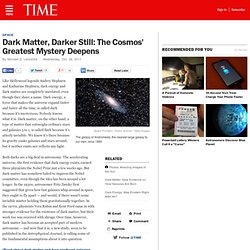
Dark energy, a force that makes the universe expand faster and faster all the time, is called dark because it's mysterious. Nobody knows what it is. Dark matter, on the other hand, a type of matter that outweighs ordinary stars and galaxies 5 to 1, is called dark because it's utterly invisible. We know it's there because its gravity yanks galaxies and stars around, but it neither emits nor reflects any light. Both darks are a big deal in astronomy. Dark Matter & Dark Energy. Dark energy. Outer Space. Antimatter. In modern physics, antimatter is defined as a material composed of the antiparticle (or "partners") to the corresponding particles of ordinary matter.
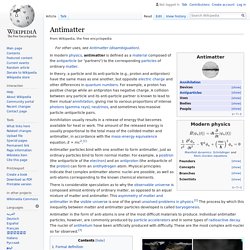
In theory, a particle and its anti-particle (e.g., proton and antiproton) have the same mass as one another, but opposite electric charge and other differences in quantum numbers. For example, a proton has positive charge while an antiproton has negative charge. A collision between any particle and its anti-particle partner is known to lead to their mutual annihilation, giving rise to various proportions of intense photons (gamma rays), neutrinos, and sometimes less-massive particle–antiparticle pairs. Annihilation usually results in a release of energy that becomes available for heat or work. Dark energy. I wonder if this could be do. “Red Nugget” Galaxies Were Hiding in Plain Sight. In 2005 the Hubble Space Telescope spotted unusually small galaxies densely packed with red stars in the distant, young universe.
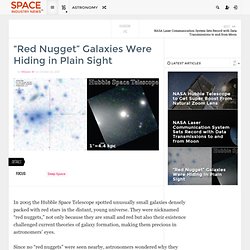
They were nicknamed “red nuggets,” not only because they are small and red but also their existence challenged current theories of galaxy formation, making them precious in astronomers’ eyes. Since no “red nuggets” were seen nearby, astronomers wondered why they had disappeared over time. New research shows that they didn’t disappear completely. In fact, they were simply hidden within the data of previous surveys. Astronomers now realize these newfound compact galaxies could represent a missing link between distant “red nuggets” and nearby elliptical galaxies. To find them, astronomer Ivana Damjanov (Harvard-Smithsonian Center for Astrophysics) and her colleagues searched databases from the Sloan Digital Sky Survey.
“The View From Mars: Part One: ALMA (Atacama Large Millimetre Array)” by Jonathan de Villiers - NOWNESS. Astronomers Discover that the Milky Way Wobbles. Velocity map of the extended solar neighborhood as seen by RAVE.
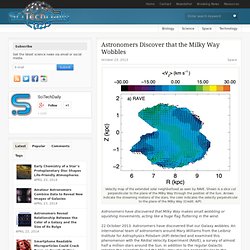
Shown is a slice cut perpendicular to the plane of the Milky Way through the position of the Sun. Arrows indicate the streaming motions of the stars, the color indicates the velocity perpendicular to the plane of the Milky Way (Credit: AIP). Astronomers have discovered that Milky Way makes small wobbling or squishing movements, acting like a huge flag fluttering in the wind. 22 October 2013. Astronomers have discovered that our Galaxy wobbles. It is common knowledge that our Galaxy is permanently in motion. Largest Spiral Galaxy in the Universe Confirmed. The spectacular barred spiral galaxy NGC 6872 has ranked among the biggest stellar systems for decades.

Now a team of astronomers from the United States, Chile and Brazil has crowned it the largest-known spiral, based on archival data from NASA's Galaxy Evolution Explorer (GALEX) mission, which has since been loaned to the California Institute of Technology, Pasadena, Calif. Measuring tip-to-tip across its two outsized spiral arms, NGC 6872 spans more than 522,000 light-years, making it more than five times the size of our Milky Way. BORG Survey Finds Oldest Known Galaxy Cluster in Universe. Galaxy clusters are the largest structures in the Universe, comprising hundreds to thousands of galaxies bound together by gravity.

This developing cluster, or protocluster, seen as it looked 13 billion years ago, presumably has grown into one of today's massive cities of galaxies, comparable to the nearby of more than 2000 galaxies. "These galaxies formed during the earliest stages of galaxy assembly, when galaxies had just started to cluster together," says the study's leader, Michele Trenti (University of Cambridge, UK and University of Colorado). Remnant of a Dwarf Galaxy Devoured by the Milky Way. Astronomer Mary Williams, who is working with an international team in Germany on a million-star survey, found the "Aquarius Stream.

" "It was right on our doorstep, but we just couldn't see it. " Although models predicted that big galaxies such as the Milky Way were surrounded by dwarf galaxies, Prof Watson said astronomers rarely saw them. Gigantic Disc of Dwarf Galaxies Discovered Orbiting Andromeda. A newly discovered form of circle dancing is perplexing astronomers; not due to its complex choreography, but because it's unclear why the dancers – dwarf galaxies – are dancing in a ring around the much larger Andromeda Galaxy.
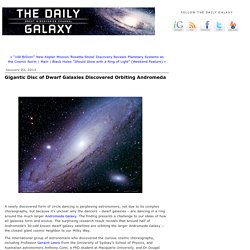
The finding presents a challenge to our ideas of how all galaxies form and evolve. The surprising research result reveals that around half of Andromeda's 30-odd known dwarf galaxy satellites are orbiting the larger Andromeda Galaxy – the closest giant cosmic neighbor to our Milky Way. "When we looked at the dwarf galaxies surrounding Andromeda, we expected to find them buzzing around randomly, like angry bees around a hive.
"Instead, we've found that half of Andromeda's satellites are orbiting together in an immense plane, which is more than a million light years in diameter but only 30 000 light years thick. Our Solar System Is Surrounded by Supernovae Debris. It took just five minutes for a NASA sounding rocket to confirm the decades-old theory that the solar system sits within a bubble of gas produced in 10 million-year-old supernovae explosions.

Astronomers find the first sibling of the sun. Sen—A team of researchers has identified for the first time a star directly related to the Sun, one almost certainly born from the same cloud of gas and dust.

The find, led by astronomer Ivan Ramirez of The University of Texas, will help astronomers look for other solar siblings. It could lead to an understanding of how and where our Sun formed, and how our Solar System became hospitable for life. “We want to know where we were born,” Ramirez said. Galaxy. Astronomy. Forced emergency landing on Mars Myth or Reality Documentary National Geographic 2016.